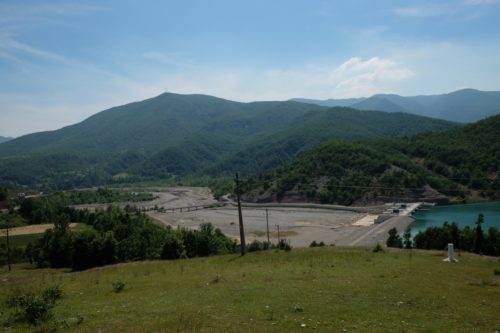++ Two European-financed hydropower projects are causing significant damage to nature and people’s livelihoods, finds a new study by CEE Bankwatch Network released today.
December 20th, 2017. Prague, Tirana. A field visits to the Rrapuni and Tërnovë hydropower plants in June 2017 showed that there is an almost complete lack of implementation of the monitoring by the Albanian authorities. Both plants are financed by the European Bank for Reconstruction and Development (EBRD). In both cases, environmental destruction is accompanied by a shortage of water for the local community use. Additional infrastructure, such as access roads has brought further destruction to pristine environment.

Notably, the Rrapuni 1 & 2 hydropower plant, close to Librazhd, is not releasing enough water into the riverbed to support aquatic life and functioning of the traditional cornflower mill. This also affects in the aggravation of the problem created a few hundred meters downstream by the Rrapuni 3 & 4* plant owned by the Albanian Orthodox Church where no water at all is left to flow in the river bed.
Rrapuni 1 & 2 is located in the Shebenik-Jabllanicë National Park. The area is under extreme pressure from hydropower development: 45 concessions for hydropower plants have been awarded within the Park.
At the same time, the Tërnovë hydropower plant, above the town of Bulqizë, is destroying natural ecosystems connected to the Black Lake Nature Monument on top the Maja e Gjatë Mountain, with 23 km of derivation channels and about 30 km of access roads planned altogether. The project is causing massive erosion alongside the pipeline that directs water to the power plant, and is transporting together with water a considerable amount of sediment to this lake, was found out During the Bankwatch’s visit in June 2017
Olsi Nika from EcoAlbania and the Albanian coordinator of the Blue Heart Campaign notes: “These are just a few cases that show the weakness of Albanian law enforcement agencies on the nature protection and on monitoring of the environmental criterias set in the environmental permits of the hydropower projects. The environmental mitigation measures are not taken seriously into account by the companies as there is no pressure on them regarding the law enforcement by the state authorities Therefore the harmful way of operation seems to be normal in most of the existing hydropower projects”.
The EBRD has acknowledged Bankwatch’s findings. The bank’s consultants visited the plants in July 2017 and concluded that among other things the Rrapuni 1 & 2 Company needs to release at least 300 l/s of water in the riverbed, while the Tërnovë Company needs to reforest and rehabilitate the area, as well as build sediment traps to avoid further damage to the Black Lake.
Still it is unclear whether these commitments will be fulfilled as the public is deprived of access to the Action Plans approved by the EBRD’s client companies.
“The EBRD has taken a first step and admitted problems with its investments. Now it needs to release all the remediation plans and fulfill what it committed to, implementing measures to mitigate the detrimental impacts of Rrapuni and Tërnovë power plants”, says Igor Vejnovic, Bankwatch’s hydropower policy officer.
This study was conducted as part of the campaign “Save the Blue Heart of Europe” and can be found at the LINK
General information:
About 2700 new dams are currently projected between Slovenia and Albania. In order to counteract this spate of destruction, EuroNatur and RiverWatch have launched the “Save the Blue Heart of Europe” campaign in cooperation with local partners in the respective Balkan countries.







